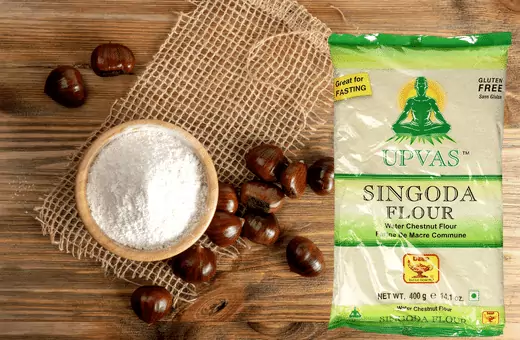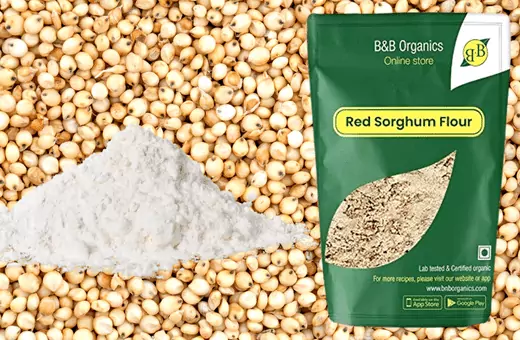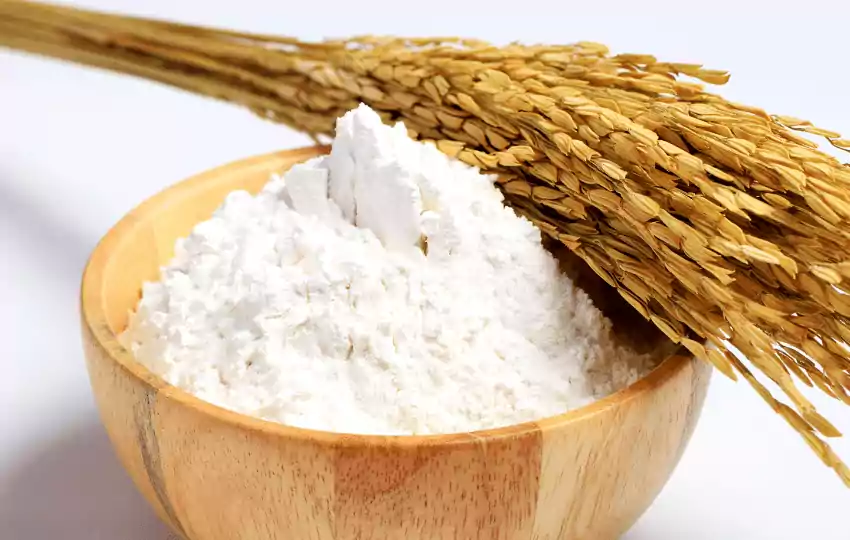When substituting brown rice flour, everyone wants to know,” is there any substitute for brown rice flour?” I must say yes.
There are lots of options that give similar texture and health benefits, like brown rice flour. You just need some quantity adjustment.
The most popular substitutes for brown rice flour are almond flour, chestnut flour, and buckwheat flour. All of these substitutes can be found in the grocery store or online.
Read More to explore more…
What is Brown Rice Flour?
Brown rice flour is a type of flour made from ground brown rice. It has a nutty flavor and is a good choice for people who are gluten-free or have other food allergies.
Brown rice flour is good for making baked goods; frying and thickening are also used to make bread, pizza crusts, and other baked goods. Brown rice flour is also high in fiber and protein.
What is the best substitute for Brwon rice flour?
1. Almond flour is an excellent choice for brown rice flour
Almond flour is an excellent choice for brown rice flour because it has a similar texture and a mild flavor. It has a nutty flavor and a slightly sweet taste that pairs well with the earthiness of brown rice flour.
Almond flour can also be used to thicken sauces, soups, and stews. It is perfect for baking because it helps produce a light and fluffy texture.
Almond flour is a great source of protein, fiber, and vitamins E and B2. It can be used in place of wheat flour in most recipes. It is also gluten-free, which makes it a great choice for people with gluten sensitivities.
2. Chestnut flour- Good Substitute for Brown Rice flour in baking
Chestnut flour is made of the ground nuts of the chestnut tree. It is a type of flour that is used in baking. It has a sweet, nutty flavor and is often used in desserts, and has a slightly denser texture than other types of flour.

Chestnut flour can be used to make a variety of different dishes, including bread, cakes, and pastries. It can also be used to thicken sauces or to coat chicken or fish.
Chestnut flour is a good source of protein and fiber, and it also contains some vitamins and minerals. It is available in most grocery stores.
3. Brown rice flour substitute for whole wheat flour
Whole wheat flour is often alternated with brown rice flour. This can make the baked goods a little denser, but it also increases the fiber and nutrient content.
If you are looking to reduce the amount of gluten in your baked goods, you can try substituting some of the wheat flour with almond meal or coconut flour. These flours are lower in gluten and will result in a more fragile product.
Alternatively, you can use a gluten-free baking mix. Just be sure to read the ingredients list carefully, as not all mixes are created equal. Some contain high levels of sugar or unhealthy fats, so you’ll want to choose one that is as healthy as possible.
4. Millet Flour
Millet Flour is another substitute for brown rice flour. Millet flour is obtained from grinding the whole grain of millet. It is a good source of dietary fiber, minerals (especially magnesium, potassium, and zinc), and vitamins (especially B vitamins).
Millet flour can be used in combination with other gluten-free flour or as a sole flour in recipes.
It has a slightly sweet taste and creates a fluffy texture. Like brown rice flour, millet flour can be used to make bread, pizza crusts, muffins, and other baked goods.
5. Buckwheat flour
Buckwheat flour is another excellent replacement for brown rice flour in gluten-free baking. It has a more earthy flavor than rice flour and a slightly coarser texture, so it’s best to combine it with other gluten-free flours when baking.
Like rice flour, buckwheat flour is high in carbohydrates and low in protein, so it’s not the best choice for folks who are looking to boost their protein intake.
Buckwheat flour is a great option for people with gluten sensitivities, as it is gluten-free.
Additionally, buckwheat flour has a nutty flavor that pairs well with sweet or savory dishes. Like brown rice flour, you can use buckwheat flour for pancakes, waffles, and biscuits.
Whether you have a food processor, you can also use buckwheat flour to make your own flour blend.
Just combine one cup of buckwheat flour with two cups of another gluten-free flour for a perfect substitution in all your favorite recipes. Try the best substitution for Buckwheat flours.
6. Plain flour
When you can’t find any substitution for brown rice flour, use All-purpose flour instead for frying and thickening.
However, it will not add the same flavor or nutrients as brown rice flour. All-purpose flour is made from a blend of wheat and other grains, so it may contain gluten which some people are sensitive to.
7. Tapioca starch
Tapioca starch is another good alternative to brown rice flour.
Tapioca flour is obtained from the dried root of the cassava plant. It is a fine, white flour that is high in starch and gluten-free.
It can be used as a thickener for soups and sauces or as a coating for foods that are to be fried.
Like brown rice flour, tapioca flour can be used to make bread, pancakes, and other gluten-free dishes.
8. Potato starch
Another good alternative to brown rice flour is Potato starch. It is a good thickener for sauces, gravies, and soups.
Potato starch also has a neutral flavor, so it will not alter the taste of your dish.
9. White rice flour
There are many reasons to choose white rice flour over brown rice flour, even if you don’t need a gluten-free diet.
For one, white rice flour is a finer flour, meaning that it has a smoother texture and can be used in more recipes.
It is also slightly sweeter than brown rice flour, which can give your baked goods a more pleasing flavor.
Finally, white rice flour is easier to digest than brown rice flour, making it a good choice for those with digestive issues.
10. Sorghum Flour
Sorghum Flour is another good substitute for brown rice flour. It has a good source of dietary fiber, thiamin, niacin, and vitamin B6.

Sorghum flour also contains minerals such as calcium, magnesium, and potassium. Like brown rice flour, it has a mild flavor that won’t overpower other ingredients in your recipe.
Check more- Ideal Sorghum flour alternatives
How to make brown rice flour?
Making your own brown rice flour is a great way to ensure that you know exactly what’s in it. It’s also very economical since brown rice is relatively inexpensive. You’ll need a food processor or blender and about 15 minutes of your time.
To make the flour, first, rinse the brown rice under cold water. Then, put it into the food processor or blender and pulse until it’s a fine powder. Be careful not to over-blend, or you’ll end up with mush!
If you want to store the flour, put it in an airtight container and keep it in a cool, dry place. It should keep for about six months. Enjoy!
Brown rice flour vS white rice flour
The difference between brown rice flour and white rice flour is that brown rice flour is made from the entire grain, while white rice flour is made from just the kernel. This means that brown rice flour contains all of the nutrients of the grain, including the bran and germ.
White rice flour does not contain these parts of the grain, so it is not as nutritious. Brown rice flour also has a slightly nuttier flavor than white rice flour.
Can regular flour be substituted for brown rice flour?
There is no one-size-fits-all answer to this question, as the substitution of regular flour for brown rice flour will depend on the recipe you are using.
That said, many people find that substituting a small amount of brown rice flour for regular flour in baking recipes can give baked goods a nuttier flavor and chewier texture.
If you are looking to make a complete switch to using brown rice flour in all of your recipes, it is important to do some experimentation because different recipes will require different quantities of flour. Happy baking!
Substitute brown rice flour for whole wheat
Replace whole wheat flour with brown rice flour when baking. Brown rice flour is a whole grain and contains bran, endosperm, and germ.
This means that it is high in fiber, has a low glycemic index, and is a good source of minerals like magnesium, phosphorus, and potassium.
When baking with brown rice flour, you may need to adjust the amount of liquid that you use, as this flour can be more absorbent than other types of flour. Start by adding a little bit of liquid at a time until the desired consistency is reached.
You may also need to adjust the baking time and temperature, as brown rice flour can cook differently than other flours.
If you are new to baking with brown rice flour, it is a good idea to start with a recipe that is specifically designed for this type of flour.
There are many recipes available online and in cookbooks, so you should be able to find one that fits your needs. Happy baking!
Can I substitute almond flour for brown rice flour?
Yes, you can substitute almond flour for brown rice flour in most recipes. Almond flour is an excellent option for people with gluten sensitivities because it is gluten-free. You can find almond flour at most grocery stores or online.
When substituting almond flour for brown rice flour, remember that almond flour is denser than brown rice flour. This means that you may need to reduce the amount of almond flour called for in a recipe by about 25%.
Additionally, almond flour has a higher fat content than brown rice flour, so you may need to adjust the other ingredients in the recipe accordingly. For example, if a recipe calls for oil, you may need to reduce the amount of oil by about 25%.
Overall, almond flour is an excellent substitution for brown rice flour in most recipes. It has a similar taste and texture, and it is gluten-free.
Just be sure to reduce the amount of almond flour called for in the recipe by about 25%, and adjust the other ingredients as needed. Enjoy!
FAQs on Brown Rice
Q1. Substitute brown rice flour for oat flour
Substitute brown rice flour for oat flour is a good choice. Brown rice flour is heavier than oat flour, so you may need to adjust your recipe accordingly. But it’s a great option if you’re looking to add some extra fiber to your baked goods.
Q2. Is brown rice flour healthy?
Brown rice flour is generally considered healthier as it contains more nutrients than white rice flour.
However, this also means that it has a slightly grainier texture and a nuttier flavor. White rice flour is less nutritious but has a smoother texture and a milder flavor.
Finally, the decision of whether or not to use brown rice flour comes down to personal preference.

